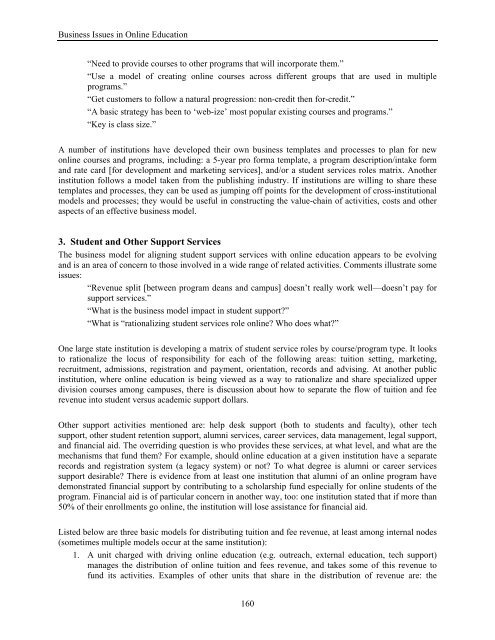Elements of Quality Online Education cation
Elements of Quality Online Education cation
Elements of Quality Online Education cation
You also want an ePaper? Increase the reach of your titles
YUMPU automatically turns print PDFs into web optimized ePapers that Google loves.
Business Issues in <strong>Online</strong> <strong>Edu<strong>cation</strong></strong>“Need to provide courses to other programs that will incorporate them.”“Use a model <strong>of</strong> creating online courses across different groups that are used in multipleprograms.”“Get customers to follow a natural progression: non-credit then for-credit.”“A basic strategy has been to ‘web-ize’ most popular existing courses and programs.”“Key is class size.”A number <strong>of</strong> institutions have developed their own business templates and processes to plan for newonline courses and programs, including: a 5-year pro forma template, a program description/intake formand rate card [for development and marketing services], and/or a student services roles matrix. Anotherinstitution follows a model taken from the publishing industry. If institutions are willing to share thesetemplates and processes, they can be used as jumping <strong>of</strong>f points for the development <strong>of</strong> cross-institutionalmodels and processes; they would be useful in constructing the value-chain <strong>of</strong> activities, costs and otheraspects <strong>of</strong> an effective business model.3. Student and Other Support ServicesThe business model for aligning student support services with online edu<strong>cation</strong> appears to be evolvingand is an area <strong>of</strong> concern to those involved in a wide range <strong>of</strong> related activities. Comments illustrate someissues:“Revenue split [between program deans and campus] doesn’t really work well—doesn’t pay forsupport services.”“What is the business model impact in student support?”“What is “rationalizing student services role online? Who does what?”One large state institution is developing a matrix <strong>of</strong> student service roles by course/program type. It looksto rationalize the locus <strong>of</strong> responsibility for each <strong>of</strong> the following areas: tuition setting, marketing,recruitment, admissions, registration and payment, orientation, records and advising. At another publicinstitution, where online edu<strong>cation</strong> is being viewed as a way to rationalize and share specialized upperdivision courses among campuses, there is discussion about how to separate the flow <strong>of</strong> tuition and feerevenue into student versus academic support dollars.Other support activities mentioned are: help desk support (both to students and faculty), other techsupport, other student retention support, alumni services, career services, data management, legal support,and financial aid. The overriding question is who provides these services, at what level, and what are themechanisms that fund them? For example, should online edu<strong>cation</strong> at a given institution have a separaterecords and registration system (a legacy system) or not? To what degree is alumni or career servicessupport desirable? There is evidence from at least one institution that alumni <strong>of</strong> an online program havedemonstrated financial support by contributing to a scholarship fund especially for online students <strong>of</strong> theprogram. Financial aid is <strong>of</strong> particular concern in another way, too: one institution stated that if more than50% <strong>of</strong> their enrollments go online, the institution will lose assistance for financial aid.Listed below are three basic models for distributing tuition and fee revenue, at least among internal nodes(sometimes multiple models occur at the same institution):1. A unit charged with driving online edu<strong>cation</strong> (e.g. outreach, external edu<strong>cation</strong>, tech support)manages the distribution <strong>of</strong> online tuition and fees revenue, and takes some <strong>of</strong> this revenue t<strong>of</strong>und its activities. Examples <strong>of</strong> other units that share in the distribution <strong>of</strong> revenue are: the160
















